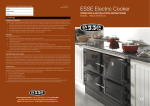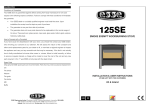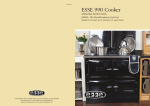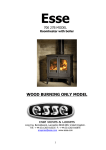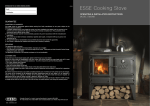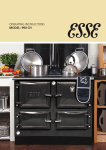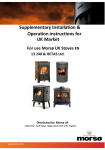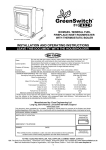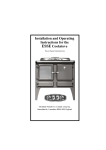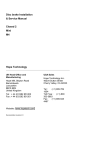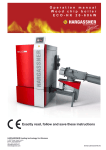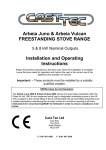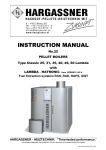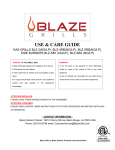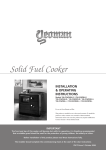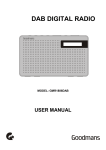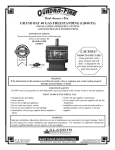Download Esse Plus 1 Operating instructions
Transcript
Vers 11/12 ESSE Engineering Limited, Ouzledale Foundry, Long Ing, Barnoldswick, Lancashire BB18 6BN Tel: 01282 813235 Fax: 01282 816876 E-mail: [email protected] Website: http://www.esse.com On-line store: http://esseparts.com ESSE Plus 1 Cooking Stove INSTALLATION, COMMISSIONING AND OPERATING INSTRUCTIONS MODEL: Plus 1 Wood/Smokeless Solid Fuel Master Stove Makers since 1854 ESSE Plus 1 Cooking Stove INSTALLATION, COMMISSIONING AND OPERATING INSTRUCTIONS TABLE OF CONTENTS General Safety Information Page 2 Cooking on a Hot Plate Page 10 Chimney and Flue Information Page 3 General Advice Page 10 Flue Draught Page 4 Cooking in the Oven Page 10 Installing the Appliance Page 5 Ash Removal Page 11 Commissioning the Appliance Page 5 Seasoning and Storing Firewood Page 12 Chimney and Flue Page 6 The Wood Burning Process Page 13 Replacement Parts Page 7 What Type of Wood is Best Page 14 Hot Water System Page 7 The Importance of a Healthy Flue Page 15 Operating your Plus 1 Page 8 Cleaning the Flue Ways Page 16 Safty Notes Page 8 Operating Tips Page 17 Before using your Cooker Stove Page 9 Cleaning the Exit Flue Page 17 Lighting and Controlling the Cooker Page 9 Warranty information Page 18 GENERAL SAFETY INFORMATION In the UK, the installer has a responsibility under the Health and Safety at Work Act 1974 to provide for the safety of persons carrying out the installation. Attention is drawn to the fact that fire cement is caustic and hands must be washed thoroughly after use. The appliance is heavy and care must be taken during handling. Although the appliance does not contain asbestos products, it is possible that asbestos may be disturbed in existing installations and every precaution must be taken. These instructions give a guide for the installation of the appliance but in no way absolve the installer from responsibilities to conform to British Standards, in particular BS8303 and BS6461, relating to the installation of solid fuel appliances. All local regulations including those referring to national and European standards need to be complied with, when installing this appliance. Outside of the UK, the installer must comply with all local, national & European standards that apply. Any adjacent combustible material should be far enough away from the appliance so as not to raise 60ºC above the room temperature when the appliance is in operation. If necessary, any adjoining walls should be protected from the effects of heat. Clearances from combustible materials are 20mm from the sides and 40mm from the rear. It is also recommended that a smoke alarm and appropriate fire safety equipment such as a fire extinguisher and fire blanket are installed in the kitchen as a safety precaution and also a carbon monoxide detector. An adequate air supply for combustion and ventilation is required. A purpose provided air vent is necessary. Air openings provided for this purpose must not be restricted. Warning: This appliance is not suitable for installation in a shared flue system TECHNICAL INFORMATION Nominal heat output 5.0kW Combustion air requirements 29m3/h Weight of appliance 100kg Minimum chimney draught 12Pa Mean flue gas temperature 170°C Flue gas mass flow 10g/s 2 Fig.1 – Cooker Dimensions Note: All Dimensions are in milimetres 500 mm Warning 900 mm The appliance gets very hot especially the top and firedoor and extreme care should be taken when using the appliance. CHIMNEY AND FLUE INFORMATION CHIMNEY AND FLUE INFORMATION The successful operation of the cooking appliance relies on the adequate performance of the chimney to which it is connected. The following chimney guidelines must be followed: • It should have an internal cross section of no less than 320cm2 (200mm dia.) (If a flue liner is used, it should be 150mm (6’’) diameter and be made of suitable material for burning wood). A Flue with a diameter of 150mm (6’’), is required to connect to the cooker. • Be connected to this one appliance only. • Voids in the chimney should be avoided, as these will prevent a steady flue draught. The appliance flue pipe should pass beyond the narrowing of the chimney. • A flue/chimney access point is required so that the state of the chimney can be checked and any fallen soot removed. • Terminate at least 1m above roof level so that the chimney does not terminate in a pressure zone. • If the appliance is installed as a freestanding appliance, it should not support any part of the chimney. • New chimneys must be in accordance with local regulations. • The chimney must be capped to prevent ingress of rain. • External flues must be insulated to prevent heat loss. • Do not fit an extractor fan in the same room as the appliance. • Be a minimum 4.6m high from top of the cooker to the chimney pot. • Be free from cracks, severe bends, voids, and obstructions. 3 Note: The chimney/flue to which this appliance is being connected must be swept and examined for soundness prior to installation. Remedial action should be taken if required, seeking expert advice if necessary. Where the chimney is believed to have served an open fire installation it is possible that a higher flue gas temperature from a closed appliance may loosen deposits that were firmly adhered, with the consequent risk of flue blockage. It is therefore recommended that the chimney be swept a second time within a month of regular use after installation. FLUE DRAUGHT The chimney can be checked before the appliance is installed with a smoke match. If the chimney doesn’t pull the smoke, it may suggest the chimney needs attention. Note: This test is only a guide as an apparently poor flue may improve once the appliance is installed, lit and the flue is warmed. Once the appliance is installed a flue draught reading should be taken. Flue Draught Readings Two flue draught readings should be taken, one with the appliance at minimum burning rate and one at maximum burning rate. The flue draught test hole must be drilled in the flue pipe as close to the appliance as possible and before any flue draught stabiliser. Minimum reading: The appliance should be lit and allowed to warm the flue thoroughly. Close the air controls, and ensure firebox door is fully closed. Allow the burning rate to become steady. The flue draught reading should now be taken; the minimum required is 12 Pascals [Pa] (0.05’’ w.g.). Maximum reading: The air controls can now be opened to allow the appliance to burn at maximum rate. Take a flue draught reading. Ideally, the flue draught readings should range between 12Pa, 0.12mm (0.05’’ w.g.) and 24Pa, 2.5mm (0.1’’ w.g.). Any readings significantly outside this range may indicate the need for remedial action. Low flue draught symptoms: difficult to light and smoke coming into the room. High flue draught symptoms: fuel burns away very quickly, overfiring which may damage the appliance & invalidate the warranty. Flue Stabiliser A flue stabiliser can be fitted to reduce the draught through the appliance if the draught is too high. The flue stabiliser should be fitted in the same room as the appliance and be the same size as the flue pipe. Consult building regulations regarding additional ventilation. Positioning The appliance should be sited on non-combustible material. Placing the cooker Do not use the towel rail as a lifting rail as damage will occur. 4 INSTALLING THE APPLIANCE Flue Connection The flue pipe used to connect the appliance to the chimney is 6’’ (150mm) in diameter. A 5-6’’ adaptor is supplied to connect to the flue box of the cooker. (The flue connection is on the top of the appliance, in the centre at the back.) Important Installation Notes 1. The installation must allow access for adequate chimney sweeping and flue cleaning. 2. Avoid using bends greater than 45º to the vertical. All flue pipe sections should be as close to the vertical as possible. 3. All joints in the flue system must be effectively sealed. 4. All flue sockets must face upwards. On completing the installation of the appliance, the chimney, hearth and walls adjacent to the cooker must conform to local or national regulations currently in force. In the United Kingdom, the appropriate sections of the Building Regulations must be conformed to. 5. Air inlet grilles should be positioned so that they are not liable to blockage. 6. An air extraction device shall not be used in the same room as the appliance unless adequate additional ventilation is provided. 7. A flue cleaning door should be fitted to provide access for cleaning the flue and chimney. 8. Check the appliance for soundness of seals between casting and main components and that all supplied parts and fittings are correctly fitted. 9. Ensure the appliance is left operational and hand over the operating instructions and operating tools supplied. 10. Before leaving the installation demonstrate the operation of the appliance to the user. Explain all controls and flue way access for cleaning. COMMISSIONING THE APPLIANCE • Measure and record flue draught • Check ventilation • Check no extractor fan, other appliance or other flue interferes 5 • With model D, check plumbing circuit • Complete commissioning card and return to esse to validate warranty CHIMNEY AND FLUE INFORMATION CHIMNEY AND FLUE Fig.2 – Chimney and Flue Performance LOW FLUE DRAUGHT SYMPTOMS: DIFFICULT TO LIGHT AND SMOKE COMING INTO THE ROOM CAUSE REMEDY Cold chimney Line the chimney Chimney too short Extend the chimney Down draught Relocate/extend chimney terminal. Fit an anti down draught cowl. Chimney diameter too large Line the chimney Chimney obstruction Clear/sweep the chimney Restricted air supply Check for competing draughts (other chimneys, extractor hood/fans). Fit an air vent if the room is sealed. HIGH FLUE DRAUGHT SYMPTOMS: FIRE DIFFICULT TO CONTROL, FUEL WILL NOT LAST, COOKER TOO HOT, APPLIANCE DAMAGE, CHIMNEY FIRE. External wind conditions combined with chimney terminal Fit stabiliser cowl. Fit flue draught stabiliser. 6 REPLACEMENT PARTS Ashpan Optional for solid fuel Ashpan guide Optional for solid fuel Grate Optional for solid fuel Hotplate Rope ROPE/CUT.WHT-T/25x1800 Door Glass No wood burning plate 990 - 007 (Burn wood on vermicalite base) Fire Door Glass 990-007 Door Catch 990-020A Firedoor Liner 430 S/Steel 990-042 Combustor WCKCU-012 R/H & L/H Side Brick 990-001 Oven Shelf VPC-030 Fire Box Top Back Brick 990-004 Fire Box Top Front Brick 990-004A L/H & R/H Baffle Support 990-008R Vermiculite Base Brick 990-009B Vermiculite Front Brick 990-009C Baffle 990-008 HOT WATER SYSTEM A) There are two connections, both 1” BSP Female on the left hand side. Follow general notes below. B) The D boiler is of Stainless Steel construction. C) General Notes on Water System: 1) The cooker will produce hot water at differing rates depending on how it is operated. Heating control is manual, no thermostat is fitted. 2) The system must be designed to cope with loads between the maximum and minimum output. There must be sufficient gravity load to absorb 2.6 kW. 3) Cylinder is essential for domestic hot water supply, irrespective of whether the water supply is hard or soft. Minimum capacity 30 gallons. The cylinder should be as close to the cooker as possible. 7 4) Installation as a central heating system alone, i.e. without a domestic supply, is not recommended as the boiler will produce heat when the cooker is in use, irrespective of central heating demand, and primary absorption must be provided. Installation and usage without water in the boiler is not permitted, and will damage the boiler and invalidate the warranty. 5) Whichever system is chosen the layout must follow established heating engineering practice. To avoid trapping air in the boiler a 1” BSP connection must be used on the flow and return tapping, and any reduction in pipe size thereafter being made on a vertical rising pipe. The cooker must be level when fitted and the flow pipe must rise from the boiler. 6) The cylinder and pipe work should be lagged to avoid heat loss. 7) The static head must not exceed 60 feet of water. 8) A drain cock should be fitted to the lowest part of the circuit. 9) The total water capacity of the boiler is 4 litres. 10) A heat leak radiator should be fitted to absorb any excess heat that may be produced. 11) The system must be open vented. OPERATING YOUR PLUS 1 Your Esse Plus 1 is a combination appliance providing a hot plate, one oven, room heat and in the case of the D model domestic hot water. The firebox behind the top door has an inner glass door for viewing the fire, which also houses the controls. SAFETY NOTES Please refer to Installation section to ensure appliance has been correctly installed and is connected to a suitable flue. Failure to do so will seriously inhibit the cooker’s performance and could be potentially fatal. Properly installed, operated and maintained, this appliance will not emit fumes into the dwelling. However occasional fumes from deashing and re-fuelling may occur. Persistent fume emission is potentially dangerous and must not be tolerated. If fume emission persists, open doors and windows to ventilate the room. Let the fire burn out or eject and safely dispose of fuel from the appliance. Once the fire is cold, check the flue and chimney for blockages and clean if required. Do not attempt to relight the fire until the cause of the fume emission has been identified and corrected. Seek expert advice if necessary. An adequate air supply for combustion and ventilation is essential. Air openings provided for this purpose must not be restricted. Also if simultaneous operation of other heating appliances is required within the kitchen ensure that there is sufficient ventilation. Should it be likely that children, aged or infirm people approach the appliance whilst the fire door is open then a fireguard manufactured in accordance with BS 6539 should be used. Also warn children not to sit or stand on the appliance or use it as a stool or step to access cupboards or shelves above the appliance. 8 Avoid the use of aerosol sprays in the vicinity of the cooker when it is in operation and do not heat any unopened airtight containers Ensure that precautions are taken when deep fat frying, never leave the appliance unattended and ensure you have fire safety equipment available such as a fire blanket in case of emergency. When operating the cooking stove use the tools provided and follow these instructions carefully BEFORE USING YOUR COOK STOVE CHIMNEY AND FLUE INFORMATION YOUR COOKER Ensure that any plastic film used to protect surfaces has been removed (e.g. from the inside of the oven door). The hotplate has been coated with oil at the factory to prevent rusting and therefore will require wiping with a damp cloth and drying with a tea towel or kitchen roll. If you plan to burn solid fuel, remove the woodburning steel plate from on the fire grate. LIGHTING AND CONTROLLING THE COOKER Open the outer cast iron door to reveal the glass door and set primary and secondary air controls to open position (Fig.3). Fig.3 Secondary air control Open the glass door and lay the fire using rolled up paper, on top of which place small sticks of dry kindling wood. Light the fire and depending on how well the chimney is pulling, close or partially close the glass door until the kindling is well alight. Left - Closed Primary air control Right - Open Reload the fire with small logs or smokeless solid fuel. You may experience smoke back out of the firebox when reloading as the chimney may still be in the process of warming up. Allow the fuel to start to burn and when appropriate continue to refuel, building up the size of the firebed. When refuelling is required, open the glass door slowly to minimise the risk of smoke and flames escaping. Burning wood, set the controls to the desired rate. It is recommended the primary control is closed once the fire is established and stable, using the secondary control to regulate the burning rate. Care must be taken not to close the inner glass door against any logs protruding from the fire or attempt to use the door to force any logs into the firebox, as the glass will break. Burning smokeless solid fuel, it is recommended the secondary control is closed, using the primary control to regulate the burning rate. Your cooker should not be used as an incinerator and only recommended fuels are to be used. 9 COOKING ON THE HOTPLATE Heat up from cold or low can be achieved quite quickly with a fast burning fire. Once hot, the hotplate will retain temperature for long periods even as the fire burns down. On page 11 is a graph showing typical hotplate temperatures that can be achieved using quality dry wood. Machined base pans are essential, as heat passes by conduction. Wipe the hotplate regularly to remove anything that might interfere with the contact between the hotplate and the base of the pan. The hotplate is hottest to the centre, over the fire, the temperature decreasing towards the edge. (See fig.4) Fig.4 Approx working temperatures after 30 mins from lighting/refueling. 1. 300°C 2. 290°C 3. 250°C 2 4. 190°C 1 3 4 Food may be cooked directly on the hotplate, for example griddle scones, burgers, steaks, Welsh Rarebit and flat bread; eggs can be cooked on the hotplate on Bake-o-lite paper to ensure the hotplate remains clean in such instances. GENERAL ADVICE Always use the glove provided when opening and closing doors, as handles and surfaces will be hot. Take care when hanging towels etc from the rail, particularly in front of the firebox. The outer door should generally remain closed for safety. COOKING IN THE OVEN To increase oven temperatures, refuel the cooker and increase the burning rate of the fuel by use of the primary and secondary air controls, and regulate to the desired temperature. The oven is equipped with wire shelves which can be set to the desired height. The shelves have anti-pull out stops on their ends to prevent them from being pulled out inadvertently; to remove a shelf, pull forward until the stop is reached, then lift at the front and pull out of the oven. Use reverse procedure to refit. If the shelves pull straight out then they are in back to front! 10 Fig.5 Cooker Ovens KEY: Lower oven °C 300 250 200 150 100 50 Temp °C 0 15mins 30mins 45mins 60mins 90mins 2hrs 3hrs Elasped time - 6 hours 4hrs 5hrs 6hrs 60mins 90mins 2hrs 3hrs Elasped time - 6 hours 4hrs 5hrs 6hrs Cooker Hotplates KEY: Hotplate 300 250 200 150 100 50 Temp °C 0 15mins 30mins 45mins ASH REMOVAL When burning wood, only remove small amounts of ash from the grate, leaving ideally 30mm depth of ash in the bottom for best performance. Door opening tool When burning solid fuel, deash regularly using a poker. 11 SEASONING AND STORING FIREWOOD Wood, which has recently been cut and is still full of sap and water is known as "green" wood. Green wood will generally burn poorly and inefficiently, because it can have over 50% water in its cells. It may be hard to light, smoulder, not put out any heat and cause more than the usual amount of creosote to build up in your chimney. So your aim should be to dry the wood out to below 25% moisture content, this process is called seasoning. As the name implies, you should store your wood for a season or so, while it dries, but there are things you can do to speed up seasoning by cutting the wood now rather than just before you use it. Wood is composed of bundles of microscopic tubes that were used to transport water from the roots of the tree to the leaves. These tubes will stay full of water for years even after a tree is dead. This is why it is so important to have your firewood cut to length for 6 months or more before you burn it, it gives this water a chance to evaporate since the tube ends are finally open and the water only has to migrate a small distance to escape. Splitting the wood helps too by exposing more surface area to the sun and wind, but cutting the wood to shorter lengths is of primary importance. Here’s how you can tell whether your wood is ready or not: Well seasoned firewood generally has darkened ends with cracks or splits visible, it is relatively lightweight, and makes a clear "clunk" when two pieces are beat together. Green wood on the other hand is very heavy, the ends look fresher, and it tends to make a dull "thud" when struck. Another thing you can do to help is store your wood properly. Store it off the ground by building the pile on some longer logs (or whatever method you can devise). A shed or shelter with an open side makes an ideal storage place, as the air can circulate around the logs and help to dry them out. Unventilated spaces or plastic tarps, which never get taken off will prevent the drying and evaporation process and cause moulds and rot. So, if a tarp is your only option, take it off frequently to air the wood on fine days. And remember to put it back on again. Seasoned firewood will reabsorb large amounts of water if exposed to rain, snow and excessive dew, which is liable to make it rot and be unfit for making a good fire. When you build up a store of firewood, remember that the wood may start to deteriorate after 4 to 5 years, although this is of course variable and depending on storage conditions and species involved. 12 THE WOOD BURNING PROCESS Understanding what happens when wood is burnt will enable you to burn wood in a more environmentally friendly way, reduce the maintenance required for your chimney and get more out of your wood. There are 3 stages in the wood-burning process: Evaporation When you light the cooker a lot of energy will be needed at first to boil away any moisture, which is left in the wood. Using energy to drive off excess water in firewood robs the cooker of energy needed for an efficient and clean burn. Also, much of the energy wasted in evaporating water is energy that could have heated the hotplate and oven. This is a waste of wood, money and effort. The presence of all that moisture tends to keep "putting out" the fire, and therefore making it burn very poorly, which tends to produce a lot of creosote and pollution. Emissions As the heat of the fire intensifies, waste-gases (smoke) are released from the wood. Unburned smoke is emitted into the air either as pollution, or condensed in the chimney causing creosote build-up. It takes time for the air in your chimney to heat up. When it is still cold you get an effect similar to the condensation of hot breath on a colder window or mirror. So when the by-products of combustion (smoke in the form of gases) exit the cooker, and flow up into the relatively cooler chimney, condensation occurs. The resulting residue that sticks to the inner walls of the chimney is called creosote. Creosote is formed by unburned, flammable particulates present in the smoke. It is black or brown in appearance. It can be crusty and flaky, tar-like, drippy and sticky or shiny and hardened. Quite often, all forms will occur in one chimney system (see an extreme example of this on page 15). If the wood you are using is water logged, or green, the fire will tend to smoulder and not warm the chimney sufficiently. Wet wood causes the whole system to be cool, and inefficient. In contrast: dry wood means a hot fire, which results in a hot flue, and a hot flue means much less creosote clogging up your chimney. The cooker’s firebox is designed to operate at very high temperatures to burn the gases and particles released from the wood, which means less air-pollution. Charcoal When most of the tar and gasses have burned the remaining substance is charcoal (ash in it’s finer form). A hot bed of charcoals and ash can enhance the combustion process when burning larger pieces of wood. Start with a small fire to develop a bed of glowing embers. As the charcoal bed develops and the cooker heats up, slowly add larger and larger pieces of wood. It takes time to build a good charcoal bed, but it is well worth the effort. Only empty excess ash periodically and always leave a bed of ash on which to light the next fire. When wood burns it gives off volatile gases which contain calorific heat value. By running the appliance with the secondary air control open, the fuel is burnt in the most efficient manner. 13 WHAT TYPE OF WOOD IS BEST The difference between 'hard' and 'soft' woods is the density of their cells or fibres. As a general rule, the deciduous trees (those that loose their leaves in the autumn) are usually thought of as hardwoods and the evergreen trees (such as pines, firs and larches) as the softwoods. But generalisations are of course always subject to many exceptions. Some evergreens may well be harder than some deciduous trees. Birch, for example, is not very hard at all. So we should understand that there is a whole range of densities amongst our tree species, including medium dense woods, which cannot be satisfactorily classed as hard or soft. Firewood tends to be sold by volume rather than weight. Assuming that the wood is reasonably dry, the weight of a square metre of good hardwood may be double of that of a square metre of softwood. This means that the same volume of hardwood will provide you with more fuel to burn than an equal amount of softwood, simply because it contains more substance. (N.B. The price of hardwood will normally not be double that of softwood, because it took the same amount of labour to prepare. So, if a trailer full of hardwood costs more than the same size trailer full of softwood, the more expensive option may well be the most economical.) The other advantage of good hard firewoods are that the cooker does not need to be fed as often and the charcoal-beds made by the glowing wood may burn more easily overnight. However, the ideal situation would be to have a store of both hard and soft woods, because the softer woods also have distinct advantages. They light more easily than the slower burning hardwoods and if the softwoods are dry, they create a hotter, more intense fire. The draught created by the hotter fire moves the air up the chimney faster. After reading the notes opposite about the burning process, you will understand that means less pollution in the form of smoke and less creosote condensation in your chimney. The denser hardwoods tend to smoulder more easily when the fire is first lit, so their flue gas temperature will be much cooler. Because softwoods like pine and larch contain a lot of resins and pitch, a popular misconception is that they will fur up the chimney with creosote more easily than a hardwood like oak. This is not necessarily true at all. It is not the pitch that is the problem, it's the water IN the pitch. Once the water in the wood has evaporated, that pitch becomes high octane fuel! When dry, softwoods burn extremely hot! There is also the matter of seasoning to be considered. When you buy wood, it will usually have been cut in the winter of the year you buy it. Hard woods tend to take longer than softwoods to fully dry out. Softwoods cut in the previous winter should, with proper storage, be ready to burn the next autumn, whereas many hardwoods may take a bit longer than that. Oak, for example, is very slow to dry out and ideally left for two years. It is also possible to purchase pre seasoned wood or kiln dried wood. Summarising we can say that it is always sensible to buy this year for next years fuel supply and that it is very handy to have both soft and hardwoods. You can use the softwoods to start a good fire and you will have additional control over the fire (in addition to the cookers controls) by adding slower burning wood to fast ones if you want to leave the cooker without tending it for a while. Alternatively you can add some fast burning softwood logs to the slower hardwood logs to instantly revive a fire, which has been neglected. 14 THE IMPORTANCE OF A HEALTHY FLUE The successful operation of your range cooker is entirely dependent on the adequate performance (pull) of the chimney or flue to which it is connected. The following maintenance guidelines will be pointless unless the flue is also maintained and cleaned regularly. How often it needs cleaning will depend on the quality and moisture content of the wood you burn but an annual clean is recommended. A partially blocked or dirty flue can have disastrous implications for an otherwise perfectly installed cooker as can be seen below. Cooker A has been used regularly for over a year following these maintenance guidelines and with a clean flue drawing correctly. Cooker B was just 6 weeks old when the picture was taken and shows how quickly tar deposits will build up if the flue performance is poor and clogged with old soot as it was in this case. N.B. These photographs are of WN model, not Plus 1. 15 CLEANING THE FLUE WAYS - Every 3 months Always carry out cleaning procedures when the cooker is out and has been allowed to cool sufficiently to avoid burns. With time and experience you will be able to gauge the intervals between flue way cleaning more accurately. It will vary depending on the quality of your firewood and performance of your flue. Take time to get to know your cooker and inspect it at regular intervals for the first 6 months. HOT PLATE AND PRIMARY FLUE WAY Remove the hotplate and if required give the surfaces under the hotplate and above the firebox a light scrub with a wire brush and vacuum out any debris. N.B. These photographs are of WN model, not Plus 1. 16 OPERATING TIPS By taking time to get to know your cooker, following our maintenance guidelines and using good quality firewood you should enjoy trouble free operation of your Woodfired cooker but it is also worth bearing in mind these useful operating tips: Fig.6 19cm • Don’t leave the cooker lit for long periods in slumbered down mode (as you would for overnight burning), open the air control and bank up the fire periodically to heat up the cooker and flue to prevent soot build up. 36cm • Cut your logs to the size shown in Fig.6 to minimise the need for refuelling. CLEANING THE EXIT FLUE - Every 12 months Fig C Fig D Blanking plate Inspection hatch in blanking plate Inspection hatch in flue pipe 6” flue pipe connected to exit flue 6” flue pipe connected to exit flue It is essential to maintain the integrity and cleanliness of the flue to ensure that your cooker continues to perform at its best. When your cooker was installed the main flue should have been equipped with an inspection hatch; either in the blanking plate above the cooker next to the flue pipe (Fig C) or in the flue pipe itself. These hatches are designed to allow periodic access to the flue for cleaning which should ideally be done by a chimney sweep. Chimneys and flues vary widely in terms of size, shape, length and construction, but the principles of the way they work are the same. Keeping them clean and clear is essential to maintain the optimum performance of any woodburning or multi-fuel appliance. 17 CONDITIONS OF GUARANTEE Your ESSE cooker is guaranteed against defects arising from faulty manufacture for three years, subject to the following express conditions: • This cooker must be commissioned by your ESSE Dealer (or an authorised HETAS engineer) upon installation. The details must be recorded on the Commissioning card and registered with ESSE by returning the completed card. The guarantee period commences upon delivery of the cooker (subject to receipt of the correctly completed card). • The cooker has been used for normal domestic purposes only, and in accordance with the manufacturer’s instructions. • The cooker is serviced annually by the ESSE Dealer or authorised HETAS engineer, and the Service record completed. The cooker must not be serviced, maintained, repaired taken apart or tampered with by any person not authorised by us. • Any cooker or defective part replaced shall become the Company’s property. EXCLUSIONS This guarantee does not cover: • Parts deemed to be replaceable in the normal usage of the cooker. These parts are listed herewith: all firebricks, bottom grate, woodburning box, oven accessories, hotplate and door seals, door glass. • Enamel damage; the vitreous coating on your cooker is in effect an extremely thin layer of glass and as such displays all the characteristics of glass. It can easily be damaged by impact, or by spillage of cold liquids onto a hot surface. Such damage cannot be covered under this guarantee. (See also intermittent use of your cooker, below). This guarantee is personal to the original purchaser and is non-transferable. INTERMITTENT USE OF YOUR COOKER In the event of intermittent use and prolonged shutdown, it should be noted that in some circumstances enamel may be displaced due to ingress of damp. Whilst this is rare, it is most likely to occur in situations where the unused cooker remains in a unheated property. There is a layer (known as the groundcoat) between the vitreous enamel surface and the cast iron. Groundcoat is porous and if exposed (e.g. after a chip in the vitreous enamel coat), may allow damp to penetrate behind the vitreous enamel and spread through the groundcoat. Surface oxidisation of the cast iron may thereafter occur, causing the vitreous enamel to fall off. Such damage will not be covered by your warranty. We recommend that a light coating of petroleum jelly be applied to any damaged areas when the cooker is not in use to help keep out the damp, in addition to following instructions in your Operating manual. CUSTOMER CARE In the event you should require spare parts, please order through your ESSE dealer. Should you have cause for dissatisfaction with your cooker, you should contact your ESSE dealer, who will, in most instances, be able to offer you immediate assistance. • The serial number of the cooker can be found behind the right hand lower oven door. • Purchase date (please note that a valid purchase receipt or guarantee documentation is required for in-guarantee service calls). 18




















